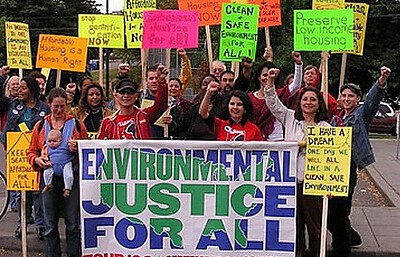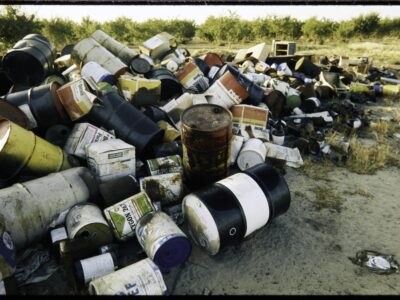California’s Environmental Justice Policies Should Serve as A Model for the Biden-Harris Administration
AB 617’s Program to Reduce Hot Spot Pollution, Port Programs, Zero Emission Trucks Could Go National
 No Presidential ticket has come into office more committed to environmental issues than President-elect Joe Biden and Vice President-elect Kamala Harris. Appropriately, climate change is at the top of their agenda. They are also committed to advancing environmental justice by addressing the disproportionate environmental harms many low income communities of color face.
No Presidential ticket has come into office more committed to environmental issues than President-elect Joe Biden and Vice President-elect Kamala Harris. Appropriately, climate change is at the top of their agenda. They are also committed to advancing environmental justice by addressing the disproportionate environmental harms many low income communities of color face.
California is often held up as a model for its leadership role on climate change and on air pollution regulation (even while it continues to face the worst air pollution in the country in Southern and Central California). Increasingly, the state has also turned its regulatory attention to a particular form of air pollution, hot spot pollution that afflicts small geographic areas where pollution sources spew toxic pollutants into neighborhoods, often low income communities of color. The programs the state has adopted should serve as a model for the Biden Administration as it seeks to address environmental injustices caused by air pollution.
Hot spot air pollution comes from predictable sources: heavily trafficked freeways and road ways; ports, and warehouses that attract huge amounts of truck traffic; and neighborhoods that surround large industrial facilities like oil refineries. And the pollution is deadly: science shows that elevated levels of pollutants in hot spot communities exacerbate asthma, increase respiratory and cardiac deaths, may cause developmental problems in children, and increase cancer risks.
Even though the Clean Air Act — our most successful national environmental law — has led to huge reductions in air pollution, essentially eliminating lead from the background air, and dramatically reducing carbon monoxide, sulfur dioxide nitrogen dioxide, ozone, and particulate pollution, the CAA’s main focus is on big air basins across huge geographic spaces (Southern California’s air district covers 11,000 square miles, for example). The statute was not really designed to tackle localized hot spot pollution, in large part because the science of exposure to close pollution sources has really developed over the past ten to twenty years (it’s been thirty years since Congress amended the Clean Air Act). So California has devised its own program, AB 617, to tackle the air pollution that harms the communities that live near its sources.
AB 617 has the potential to revolutionize how we regulate air pollution. The bill directs the state’s Air Resources Board to identify communities that have especially high air pollution exposure and to deploy extra monitoring to document community exposure to toxic and criteria air pollutants. The air districts the communities are located in must then appoint communities made up of community stakeholders and devise plans to reduce cumulative exposure levels. The idea is to incorporate both procedural and substantive environmental justice into the process.
To date, the Air Board has designated 13 communities throughout the state as Community Air Protection Program Communities. The extra monitoring has already produced some striking findings, showing that different communities suffer from different sources of pollution. Monitoring has shown that a huge source of air pollution in East Los Angeles, for example, comes from emissions from locomotives and from rail yards adjacent to rail road tracks. In Wilmington and communities surrounding the ports of Los Angeles and Long Beach, by contrast, one of the biggest sources of air pollution are the behemoth ships that dock at the ports. The oil refineries in the Wilmington area are also a huge source of concern. Though it may seem obvious that different neighborhoods would face pollution problems from different sources, the Clean Air Act hasn’t really focused on these neighborhood distinctions. AB 617 does,. And once the sources of pollution are identified, the strategies for attacking the problem are different for each neighborhood. In East L.A., air pollution regulators are cracking down on locomotives that idle and spew pollution into surrounding communities and with the vehicles that populate rail yards; in the port communities, a top priority is increasing the number of ships that plug in when docked rather than continue to run their dirty engines, along with fence line monitoring of oil refineries.. Both communities also face heavy pollution exposure from big diesel trucks and other diesel equipment.
Key to implementing AB 617 is having the financial resources necessary to convene community committees, engage in monitoring, and implement measures to reduce pollution. The implementation process has received substantial funding from the auctioning of allowances under California’s cap and trade program for greenhouse gases. The 2020-21 AB 617 budget, for example, is $235 million.
It is probably too early to assess just how successful AB 617 will be in reducing hot spot pollution with meaningful community engagement. There have been some bumps along the road, particularly in ensuring that community voices are heard and respected in the process and in maintaining stable funding. But the program is the most ambitious, meaningful hot spot reduction program in the country. It shifts the focus of air pollution away from the expansive geographic air districts that are the centerpiece of the Clean Air Act and onto local communities that have for too long borne far too much air pollution. California is not, of course, the only state to suffer from hot spot pollution in low income communities of color. The Biden-Harris Administration could use AB 617 as a model, largely with existing Clean Air Act authority (a topic for a follow up post).
AB 617 is by no means the state’s only ambitious air pollution program aimed at reducing air pollution in overburdened communities. Though pollution problems remain, a series of ambitious plans to cut pollution at Southern California’s ports of Long Beach and Los Angeles have achieved truly remarkable reductions in deadly air pollution: as of 2018, diesel particulate pollution is down almost 90 percent, NOx pollution is down 60 percent and sulfur oxides are down a whopping 98 percent. These decreases are measured from 2005, when the first Clean Air Action Plan was adopted to clean up the ports. During that time frame, cargo movement has increased by 25 percent. The L.A.-Long Beach program should be expanded to ports around the country.
California has also been at the forefront in cutting diesel emissions from the heavy duty truck fleet. Diesel pollution turns out to be one of the worst sources of air pollution. It contains over 40 chemicals that cause cancer, including arsenic, benzene and formaldehyde. And these chemicals get emitted as tiny particles that can burrow deeply in the lungs of those exposed to it, leading to asthma, breathing problems, heart issues and even cancer. Communities that live near heavily trafficked highways and places that rely heavily on diesel equipment like ports face huge health consequences as a result. Not surprisingly, these communities are overwhelmingly low income communities of color. California has not only worked with EPA to clean up new diesel engines dramatically, it has also required used truck owners to retrofit their engines with particulate filters and is phasing out old trucks from operating on California roads. And in an historic move in June of this year, the state’s air board adopted its Advanced Clean Truck rule, which will for the first time impose on truck manufacturers zero emission sales requirements that will eventually lead to the electrification of the truck fleet in the state. The rule may be the most consequential environmental justice program ever adopted, and will go a long way toward helping California meet air pollution and climate goals. And in pushing electric and zero emission truck technology forward, California will again serve as a model for the rest of the country.
California deserves its reputation as a leader on climate change. But the state’s policy contributions to tackle environmental injustice in air pollution exposure should also serve as templates for the new administration.







Reader Comments